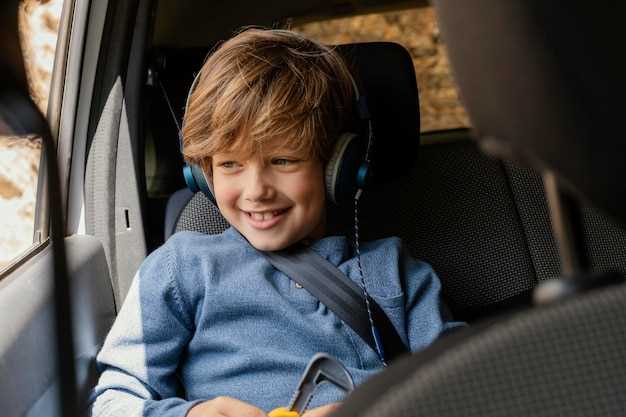
In today’s world, ensuring the safety of your child during car travel is more crucial than ever. With increasing traffic and ever-evolving road conditions, parents are constantly seeking reliable methods to protect their loved ones. Toyota, a leader in automotive design and safety, offers a range of child-focused safety features that can provide peace of mind for parents everywhere.
Understanding the innovative technologies and features available in Toyota vehicles can help parents make informed decisions when it comes to selecting a family-friendly car. From advanced airbag systems to child safety locks, Toyota prioritizes the well-being of young passengers. These features are meticulously designed to create a safer environment, allowing parents to focus on what truly matters–enjoying time spent with their children.
In this article, we will explore the essential child safety features offered by Toyota and how they can significantly enhance the protection of young passengers. By equipping yourself with this knowledge, you can confidently choose a vehicle that prioritizes the safety of your family.
Understanding Toyota’s Child Seat Compatibility and Installation Guidelines

When it comes to ensuring the safety of your child in a Toyota vehicle, understanding child seat compatibility is paramount. Toyota offers a range of vehicles equipped with the necessary features to securely install child seats of various types, including rear-facing, forward-facing, and booster seats.
Each Toyota model comes with specific child seat guidelines detailed in the owner’s manual. Familiarizing yourself with these instructions can help you select the appropriate seats that fit properly within your vehicle’s interior. Key aspects include the presence of LATCH (Lower Anchors and Tethers for Children) systems, which provide additional security for child seats, and seat belt compatibility.
When installing child seats, always check the weight and height limits specified by both the seat manufacturer and Toyota. Proper installation is crucial; therefore, follow the step-by-step guidelines provided in the manuals to secure the seats correctly. It is recommended to perform installation checks and adjustments to ensure that the seat does not move more than an inch in any direction.
Additionally, consider the seating position. Some Toyota vehicles may have particular seats that are more suitable for child installations due to their size, shape, or safety features. Always refer to the vehicle’s owner manual for specific recommendations regarding child seat placement.
For peace of mind, you can also schedule a consultation with a certified child passenger safety technician who can provide expert guidance on installing child seats correctly, helping you maximize safety for your child while traveling in your Toyota.
Exploring Advanced Safety Technologies Across Toyota Models
Toyota is committed to ensuring the safety of all passengers, especially children, by integrating a variety of advanced safety technologies across its lineup. These features not only enhance the overall driving experience but also provide parents with peace of mind when transporting their little ones.
One of the standout technologies is the Toyota Safety Sense package, which includes several proactive systems designed to prevent accidents. Key components of this package include Pre-Collision System, Lane Departure Alert, and Dynamic Radar Cruise Control. These features work collectively to enhance situational awareness and reduce the likelihood of collisions.
For families with young children, the Child Safety Locks available in multiple models provide an additional layer of protection. These locks prevent rear doors from being opened from the inside, ensuring that curious children remain safely secured while the vehicle is in motion.
Furthermore, Toyota vehicles come equipped with Advanced Airbag Systems. This ensures proper deployment and positions of airbags for optimal safety during a crash. For younger passengers, the presence of Rear-Seat Reminder alerts drivers to check the back seats, helping to prevent dangerous situations where a child may be inadvertently left behind.
Additionally, many Toyota models feature Blind Spot Monitor and Rear Cross-Traffic Alert, both vital for keeping an eye on surrounding traffic, especially when reversing or changing lanes in crowded areas. These systems help safeguard against potential accidents that could endanger both children and adults alike.
By prioritizing safety technologies, Toyota reinforces its vision of creating a secure environment for families. Parents can confidently choose Toyota, knowing that advanced safety innovations are working tirelessly to protect their most precious cargo.
Tips for Maintaining Child Safety While Driving a Toyota

Ensuring child safety in your Toyota vehicle is crucial for any parent. Here are essential tips to keep your little ones safe on the road.
First, always use the appropriate child safety seat based on your child’s age, weight, and height. Consult the vehicle’s manual to find the best installation method for your Toyota model. Make sure the seat is securely mounted and the harness is properly adjusted for a snug fit.
Regularly check the child safety seat for any recalls or safety notices. Manufacturers occasionally issue updates that can enhance safety features or address potential issues. Staying informed will help you maintain the safest environment for your child.
Teach your child the importance of buckling up. Emphasize that seat belts should always be worn when the vehicle is in motion. Explain how proper seat belt usage contributes to their safety.
Limit distractions while driving. Ensure that your child understands the importance of remaining calm and seated during the drive. Avoid letting them engage in activities that might divert your attention, such as playing loudly or throwing objects.
Adjust your driving style by practicing safe driving habits. Maintain a safe distance from other vehicles and adhere to speed limits. Being a cautious driver is key to reducing the risk of accidents, enhancing overall child safety.
Utilize your Toyota’s safety features, including rear-view cameras and parking sensors, when reversing or parking. These technologies can help minimize the chances of accidents, protecting your child and others around you.
Finally, familiarize yourself with the various safety settings and technologies in your Toyota. Features such as lane departure alerts and adaptive cruise control can assist in creating a safer driving experience for everyone in the vehicle.




